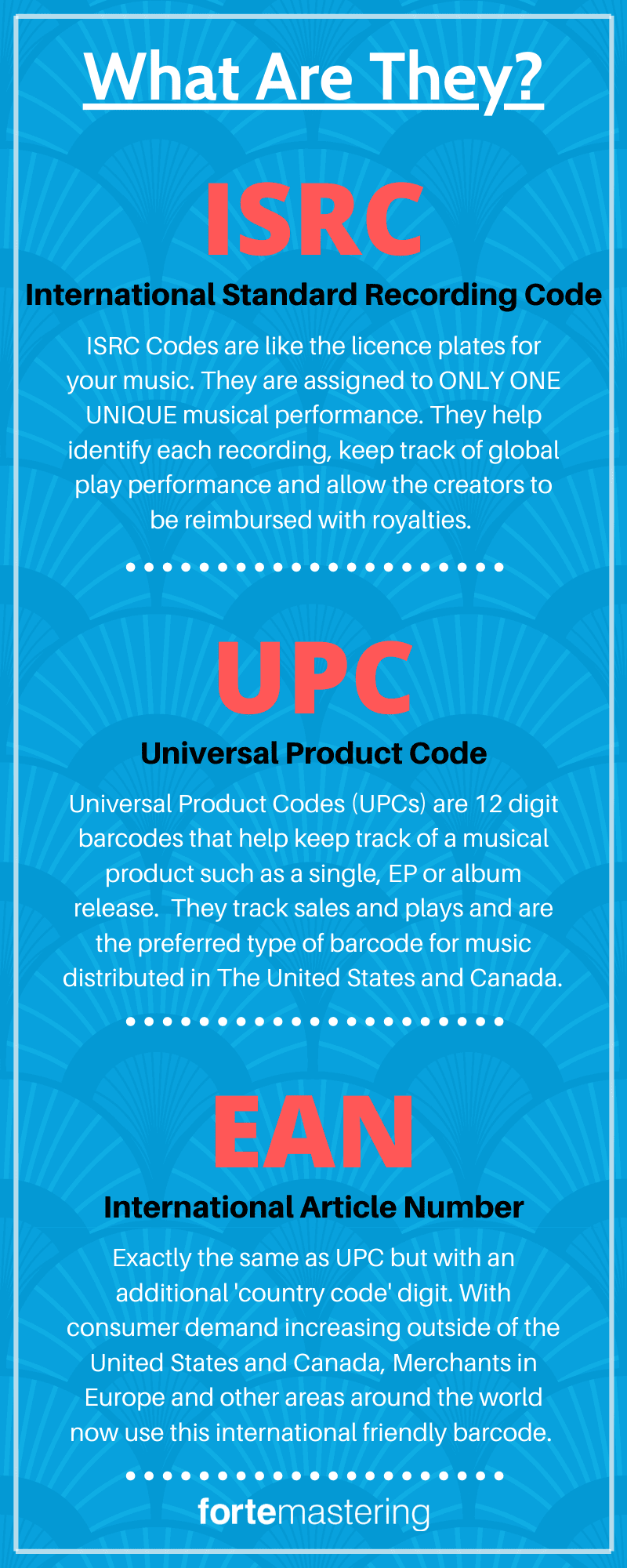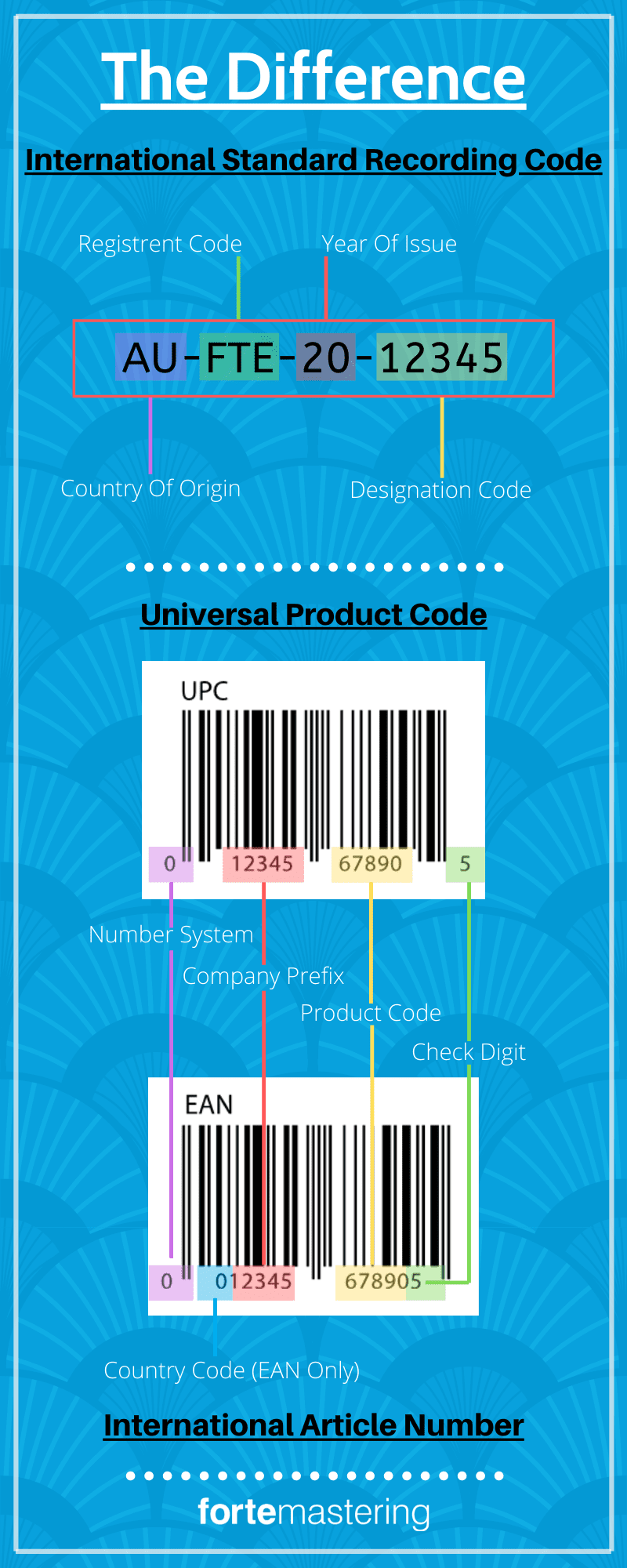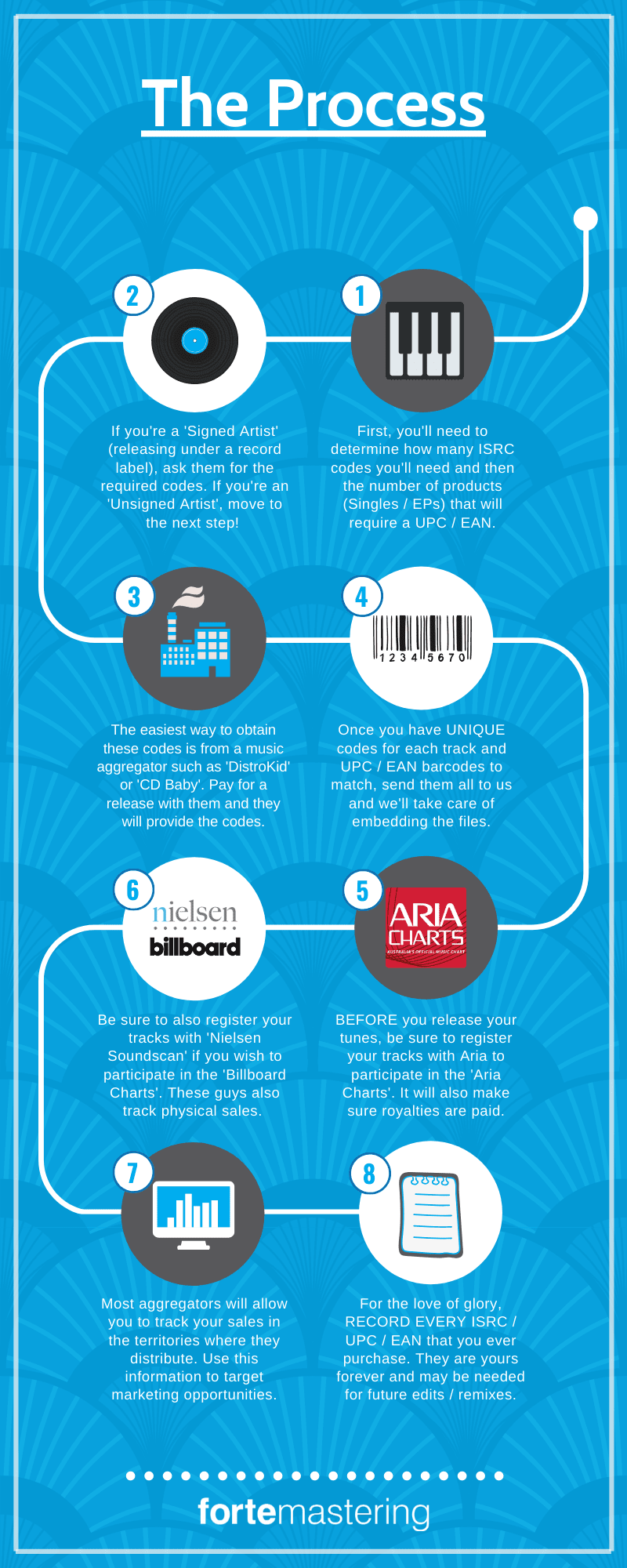OVERVIEW:
This article discusses the different codes and barcodes required when selling your music in a marketplace. We explore how each system came about and point out the differences between each. This article is invaluable for new artists on the block looking to understand how to publish and properly manage the release of their music.
TL/DR:
Every song you put out there should have its own unique ISRC code. If you're selling that track in the form of a product such as a single or within an album, you'll also need a UPC or EAN barcode. Having these systems in place allows your music to be identified for global charting and royalties collection purposes.
ISRC CODES:
International Standard Recording Codes (ISRC) were developed by the recording industry and the International Organisation for Standardisation (ISO) in 1986 as a means of tracking the sales and royalties of musical recordings. Once ISO-3901 (ISRC) was completed, the International Federation of the Phonographic Industry (IFPI) was designated as the registration authority for these new codes. The IFPI began distributing these codes in 1989 and it wasn’t long before other countries such as Japan began encoding ISRCs on audio CDs. Following the recommendations of the IFPI, the Recording Industry Association of America (RIAA) soon developed detailed recommendations for the practice of encoding these codes. Once the IFPI had adopted these recommendations, ISRC codes would now form a standard practice of cataloguing musical recordings from the 1st of January 1992.
Make sure every song you release has it’s own unique ISRC Code. ISRC Codes are like the licence plates of your music. Without them, it’s hard for royalty and sales tracking agencies to find you.
So now you know how they came about, let’s recap why they are so important. ISRC codes are a 12 digit alphanumeric code which acts as a licence plate for musical recordings. Having one unique code that is attached to a single recording, allows several things to happen. For starters, they are primarily used to identify and catalogue individual songs (tracks) on a compiled piece of work like an Album, Single or EP. Most importantly, having your music with registered ISRC codes allows royalty agencies such as APRA / AMCOS and the PPCA (for us folk in Australia) to collect information on where your music is played around the world which ensures you’re credited and paid each time that work is used. Without these ISRC codes, nobody would know who to pay or who to credit. Furthermore, your music will require ISRC codes in order to participate in the ‘Billboard Charts’. Registering your ISRC codes with ‘Nielsen SoundScan’ allows your sales figures to be counted and forwarded onto charting agencies such as the ‘Billboard Charts’. Once again, without ISRC codes, you will remain invisible to the system. See why we’re writing a whole article on these suckers?!
UPC / EAN CODES:
Universal Product Codes (UPC) and European Article Numbers (EAN) essentially serve the same purpose but with a slight difference between the two. Turn over a box of cereal or that new synth you just bought and you’ll discover a bar-stripped barcode as depicted below. They’re not only used to track your album sales online or your physical vinyl sales but are used all throughout the world as the standard in product identification. UPC-A was the original kid on the block which is a barcode that is comprised of a 12 digit number. For a period of time, it was assumed that products that were manufactured within the US and Canada would sell in these territories alone. However, rising demand in other parts of the world like Europe, Asia and Australia called for a new type of barcode that could index which country the product was manufactured in. This saw the introduction of EANs (also known as International Article Numbers) which could identify products being sold outside of the US and Canada. They are very similar to UPCs but have an additional digit which identifies the country of origin. For instance, the USA and Canada have a country code of “0”. EANs have 13 digits due to the added country code, where’s UPCs have only 12. However most of the time the “0” prefix will be dropped on EANs when the product has been manufactured in the USA or Canada.
UPC and EAN barcodes identify a product on the marketplace such as a single release or an album release. These product barcodes are important to obtain anytime you’re releasing a musical work. Once again they will be required if you wish to partake in the music charts.
So now you know the differences between the two, which one do you need? Put simply, if your fan base resides in the US and Canada, stick to a UPC. If you plan on selling your music in countries outside of those territories, you’ll need an EAN. Whilst UPCs and EANs are quite similar, some older point of sales (POS) systems in the US and Canada cannot read a 13 digit code, this is why it’s recommended to stick with a UPC. If you plan on selling your music in multiple territories around the globe, including the US and Canada, then you may want to purchase both a UPC for a US and Canada release and an EAN for a release to the rest of the world. You may have noticed that big acts will often publish multiple releases of the exact same album or work but all with different barcodes, hence why. When it comes to online distribution however, all major outlets / publishers and platforms have unified the use of a UPC for product cataloguing. It’s only when you’re dealing with a physical music release where you have to worry about UPC and EAN. Once again, these product barcodes are important to obtain anytime you’re releasing a musical work, be that of an album, EP or even a single. Similar to ISRC codes, by registering your barcode with royalty associations and ‘Nelson Soundscan’, you’ll ensure that royalties flow back to you and that you have a shot at the charts.
SUMMARY:
So to recap, an ISRC code applies to ONLY ONE unique musical recording. You will need one for EACH different recording or variation of a song you put out. Along with an ISRC code for each track, you’ll require a UPC or EAN barcode to encompass that work in the form of a product or release to the market. Whether it’s an EP, album or just a single, you’ll need a barcode to benefit from the reasons discussed above. There’s also a few things to note of when dealing with ISRC / UPC and EAN codes. If you’re an Artist or Act that is signed with a label, then when you release music through them, they should provide all the necessary codes. Generally speaking, most major music labels will have direct access to ISRC / UPC and music tracking registration agencies. If however, you’re an unsigned ‘Indie’ artist, then you have a few choices to obtain the necessary codes for your music. The first of which is to utilise an ‘Aggregator’ to distribute your music for you. Services like ‘Distro Kid’ or ‘CD Baby’ will not only supply you with unique ISRC and UPC codes but can also distribute your music onto all the major platforms for you. It’s our opinion that this is the most convenient and stress-free option for people who are unsigned. The fees are quite reasonable and most of the hard work behind the scenes is taken care of.
For ‘Indie’ Artists who’re unsigned, your best bet is to distribute and register all your releases through an aggregator. They handle all of the backend processing and save you time, stress and money.
If complete independence is your objective then the last option would require you to specifically purchase your individual ISRC codes from ‘ISRC’ directly which can cost upwards of $95. Artists residing in Australia can also apply to ARIA directly for ISRC codes which will be free of charge but can take some time to process. To obtain a unique product barcode for an album or single (be it physical OR digital), you’d need to register a company with ‘GS1’ to obtain a UPC prefix which can cost upwards of $750. You would therefore want to release a lot of music to make that investment worthwhile. You’d then have to finally register all of these codes to the necessary agencies that listen out for these codes. For royalty collections, you’d need to create an APRA / AMCOS and PPCA account (for artists residing in Australia) and register each code within your artist account. You’d then need to register all of your codes with ‘Nielsen Soundscan’ if you wish to participate in the ‘Billboard Charts’ too.
If selling your music through a ‘lemonade stand’ is your thing, all power to you, but you can see why aggregators exist in order to take all this pressure off the artist. As good as aggregators are though, most of them don’t actually forward your tracks to performance rights organisations such as (SoundScan, SoundExchange, Gracenote, BMI or ASCAP), that’s why it’s important to follow up and register anyway with APRA/AMCOS and ‘Nielsen Soundscan’. One last hot tip for ‘end of article readers’. New services such as ‘Songtrust‘ allow you to register your tunes in one place and then manage royalty collections across all bases. More on this in future articles, so stay tuned.
Frequently Asked Questions:
You need ISRC codes for each track you release. Whether you release these tracks online through spotify or sell physical CD copies, the ISRC codes will be utilised in both marketplaces to track your songs. Keep in mind, If you plan to sell an album as a digital download AND as a physical audio CD then you will need 2 UPC codes: one for the digital album download and a second one for the physical audio CD. This is the only way that performance on your individual songs can be tracked versus sales of the physical audio CD versus downloads of the complete digital album.
A single release with ‘CD Baby’ costs around $10AUD which includes your ISRC code. An extra $5AUD is required to purchase a UPC for that single. Album releases cost $49AUD which again include ISRC codes but an extra $20AUD on top is needed for an album UPC. For your reference, ISRC Codes gained through ARIA are FREE for Australian Artists but can take days or weeks to obtain these.
Any media that contains audio will generally need an ISRC code. Apart from the obvious which is musical tracks, music videos, spoken work, podcasts, audio books, training programs, skits, interviews and any other audio clips can be tracked with ISRC codes.
For Austrlaian Artist, register all your music at least one week before release on ARIA/AMCOS and the PPCA. To participate in the ‘Billboard Charts’, register all your ISRC codes and barcodes at Neilsen Soundscan.
If you have the same song occuring on multiple releases (i.e A Single, EP then a ‘Best Of’ Album), then you will not need seperate ISRC Codes for that specific song. The ISRC code for that song remains the same no matter what release this track occurs on. A new ISRC is only required if ANYTHING about the original song changes such as fade chnages, track length, title change or a remaster, etc.
The actual paring of an audio file with an ISRC code (Embedding) is not a strict requirement but we recommend it as a good standard for your releases. Most aggregators and labels will have their own portal / platform of matching ISRC codes to the tracks you have which makes embedding them a bit obsolete. However, it’s reported that ISRC embedding is now required in order to submit audio to radio stations and submit videos to ‘MTV’ & ‘VH1’ as well as parts of ‘YouTube’. Different stores and aggregators have different requirements so it’s always best practice to allow us to embed them for you anyway.
Short answer is yes. If your performance of the song is different to the original, then it will require it’s own unique ISRC code that tracks that musical performance.
Yes, you do. The registrants must be able to distinguish between ISRCs that are assigned to audio and those that are assigned to the video. Conventionally, ISRCs assigned to video are identified with a “9” in position #8 of a 12-digit video ISRC code.
If You Enjoyed This Article, Please Hit The Like Button And Share It Around :)


